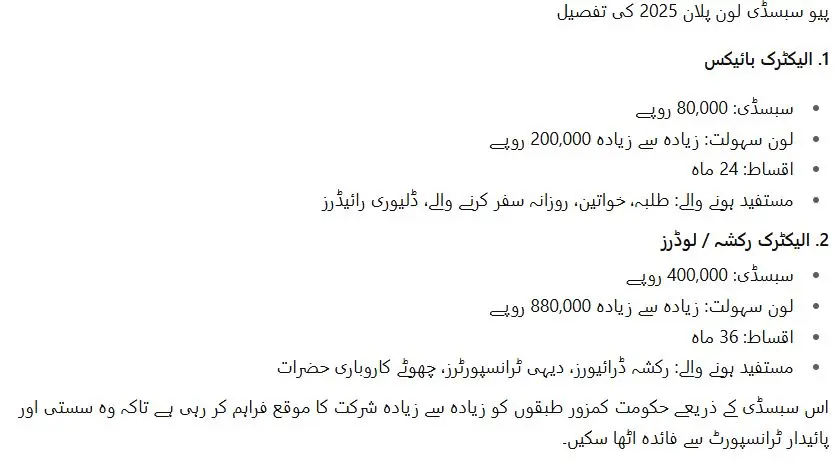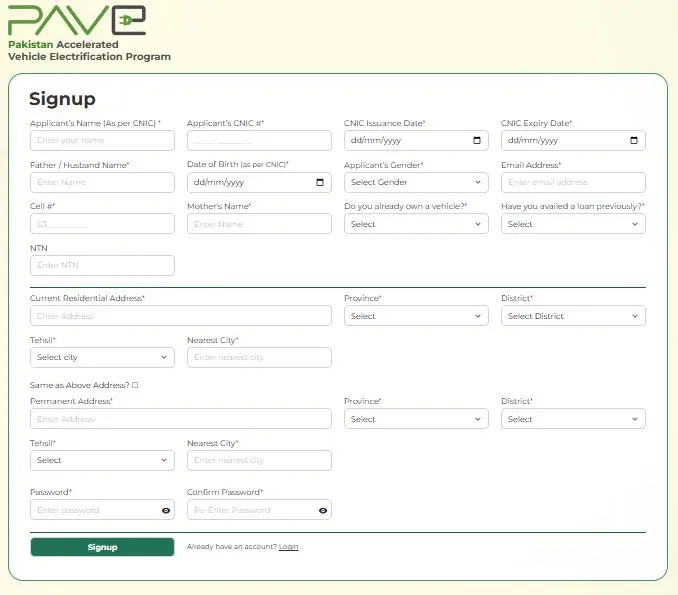PAVE Subsidy Amount 2025 – Rs 80k Bike, 400k Rickshaw
The Pakistan Accelerated Vehicle Electrification PAVE Program PAVE Subsidy Amount has become the center of attention in 2025, as thousands of citizens rush to apply for subsidized electric motorcycles and rickshaws. This initiative, introduced under the NEV Policy 2025–30, is designed to help low- and middle-income households shift from costly petrol vehicles to affordable electric options.
The government has announced a PAVE Subsidy Amount of Rs. 80,000 for electric bikes and Rs. 400,000 for electric rickshaws/loaders. But how does this subsidy actually work? Who is eligible? And what does it mean for applicants? This guide explains the complete breakdown of subsidy amounts, loan structures, and benefits for 2025.
What is the PAVE Subsidy Amount?
The PAVE Subsidy Amount refers to the financial support provided directly by the government to make electric vehicles more affordable for ordinary citizens. Instead of bearing the heavy purchase cost on your own, the subsidy reduces a large portion of the price, and applicants are only required to pay the remaining balance. This initiative has been introduced to encourage the adoption of eco-friendly transport and to reduce dependence on expensive fuel-based vehicles.
The subsidy is applied at the time of purchase, meaning you do not have to wait for reimbursements or go through lengthy claim processes. Once approved, your vehicle price is automatically adjusted to reflect the reduced amount.
Subsidy Examples:
- An electric bike priced at Rs. 280,000 will be available for just Rs. 200,000 after applying the subsidy of Rs. 80,000.
- An electric rickshaw with a market value of Rs. 1,280,000 will cost only Rs. 880,000, as the government covers Rs. 400,000 under the subsidy.
This financial assistance makes it possible for students, women, farmers, delivery riders, and low-income families to shift towards modern and sustainable electric transport without facing unbearable financial pressure.
In future phases, the subsidy may also extend to electric loaders and small EV cars, further widening the scope of benefits for different groups of society.
By reducing the upfront burden, the PAVE subsidy not only lowers purchase costs but also helps citizens save money in the long run, thanks to cheaper running costs compared to petrol or diesel vehicles.ehicles affordable even for low-income citizens who otherwise could not manage such costs.
Breakdown of PAVE Subsidy Loan Plan 2025
1. Electric Bikes
- Subsidy: Rs. 80,000
- Loan Facility: Up to Rs. 200,000
- Installments: 24 months
- Target Beneficiaries: Students, women, daily commuters, delivery riders
2. Electric Rickshaws / Loaders
- Subsidy: Rs. 400,000
- Loan Facility: Up to Rs. 880,000
- Installments: 36 months
- Target Beneficiaries: Rickshaw drivers, rural transporters, small business owners
By offering these subsidy amounts, the government ensures maximum participation from vulnerable groups who rely on affordable transport.

Why the PAVE Subsidy Amount is Significant
The PAVE Program Subsidy Amount is not just about reducing the cost of vehicles. It has broader social and economic impacts:
- Encourages EV adoption by lowering prices.
- Reduces petrol imports, saving billions in foreign reserves.
- Supports low-income families who spend a large portion of income on fuel.
- Improves public health by cutting air pollution in urban areas.
- Creates job opportunities in EV assembly, maintenance, and battery services.
PAVE Gov PK Subsidy Registration for Subsidy Amount 2025
Step 1: Online Registration
Go to www.pave.gov.pk, create an account, and verify CNIC.

Step 2: Choose Vehicle Type
Select whether you want to apply for a bike subsidy (Rs. 80,000) or a rickshaw subsidy (Rs. 400,000).
Step 3: Upload Documents
Submit CNIC, income proof, photo, and driving license (mandatory for rickshaws).
Step 4: Submit Loan Request
Choose the installment plan linked with the subsidy.
Step 5: Wait for Balloting
Applications are verified and shortlisted through computerized balloting on 1 October 2025.
Reserved Quotas Linked with Subsidy Amount
To ensure fairness, the PAVE Subsidy Amount distribution includes reserved quotas:
- A 25% quota has been reserved for women, ensuring that female students and working women can also benefit from the EV Subsidy Amount and access affordable transport.
- Special quota for delivery workers – who are directly affected by rising petrol prices.
- Fleet quota (30%) – for businesses and operators managing larger transport fleets.
- Disabled applicants – given priority in approval.
Real-Life Example of Subsidy Impact
Case 1: A Student Applying for a Bike
- Original Bike Price: Rs. 280,000
- PAVE NEV Subsidy Amount: Rs. 80,000
- Net Payable: Rs. 200,000
- Loan Facility: Rs. 200,000 (repayable in 24 months)
- Monthly Installment: Rs. 8,300 approx.
Case 2: A Rickshaw Driver Applying for a Three-Wheeler
- Original Rickshaw Price: Rs. 1,280,000
- NEV Subsidy Amount: Rs. 400,000
- Net Payable: Rs. 880,000
- Loan Facility: Rs. 880,000 (repayable in 36 months)
- Monthly Installment: Rs. 24,500 approx.
These examples show how the subsidy reduces the burden and makes EVs financially practical.
Check Also: PM Electric Bike and Rikshaw Scheme 2025
PAVE Subsidy Benefits in Pakistan Applications
Even though the PAVE Subsidy Amount scheme is transparent, applicants sometimes face issues like:
- Submitting expired CNICs.
- Uploading unclear income proofs.
- Using mobile numbers not linked to CNIC.
- Missing application deadlines.
- Expecting higher subsidy than the official PAVE Subsidy Amount.
Check Also: Maryam Nawaz e-Bike Scheme 2025 – Green Punjab Vision
Future of Subsidy Programs in Pakistan
The government has announced that future phases may include:
- Subsidies for electric cars.
- Higher subsidies for rural and agricultural EVs.
- Integration with microfinance institutions for ultra-low-income families.
This expansion shows that the PAVE Subsidy Amount in 2025 is just the beginning of Pakistan’s long-term EV revolution.
FAQs about PAVE EV Subsidy Program 2025
Q1: What is the official subsidy for electric bikes?
Each approved applicant will receive a subsidy of Rs. 80,000, which is directly adjusted in the bike’s purchase price.
Q2: How much subsidy is offered on rickshaws and loaders?
For three-wheelers like electric rickshaws and loaders, the government provides a subsidy of Rs. 400,000.
Q3: Can one person apply for more than one subsidized vehicle?
No. Under the rules, a single CNIC can only be used to get one subsidized vehicle.
Q4: Is the subsidy amount given in cash?
No. The subsidy is not handed out as cash; instead, it is deducted from the vehicle’s total price before purchase.
Q5: Who is responsible for verifying eligibility?
Your documents and details are cross-checked by NADRA along with partner banks before the subsidy is approved.
Q6: Do women have a reserved quota in the scheme?
Yes. To encourage female participation, 25% of the total quota has been allocated specifically for women.
Q7: What happens if I miss the application deadline?
Applications close on 30 September 2025. If you miss this date, you won’t be able to submit your form for the current phase.
Conclusion
The government’s decision to offer a PAVE Subsidy Amount of Rs. 80,000 on electric bikes and Rs. 400,000 on rickshaws has made eco-friendly transport a reality for thousands of families. Paired with easy loan options, this initiative tackles the biggest challenge that ordinary people face—the heavy upfront cost of buying a new vehicle.
Check Also: PM Electric Bike and Rikshaw Scheme Installment Plan 2025
If you meet the criteria, gather your documents, apply online at www.pave.gov.pk, and secure your slot before the last date. Through this program, Pakistan is not just providing affordable vehicles; it is taking a major step toward cleaner cities, reduced fuel dependence, and a sustainable transport system for the future.






